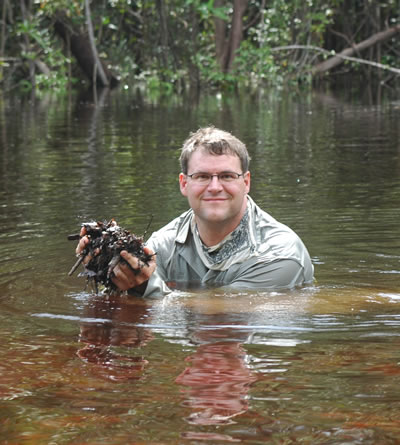Kirk Johnson is Vice President and Chief Curator of the Denver Museum of Natural & Science. He earned his Ph. D. in geology and paleobotany at Yale University in 1989 and did postdoctoral research in the rainforests of northern Australia before coming to Denver in 1991, where he directed the installation of the museum’s Prehistoric Journey exhibit. He studies fossil plants, the environmental effects of the dinosaur-smiting asteroid, and the birth and death of biomes. In 1994, He was startled by the discovery of a 64-million-year-old tropical rainforest in Castle Rock, Colorado, and responded to this anomaly by taking a dozen trips to the Amazon and by launching the Denver Basin Project, an ongoing effort to interpret the fossils and groundwater of the bedrock beneath Denver. Kirk is the author of two popular books: Prehistoric Journey: A History of Life on Earth and Ancient Denvers: Scenes from the past 300 million years of the Colorado Front Range. His next book, Cruisin’ the Fossil Freeway: an epoch tale of a scientist and an artist on the ultimate 8,000 mile paleo road trip (with Ray Troll) is coming out in July. Kirk works with artists to create accurate and plausible paintings, murals, and dioramas of prehistoric landscapes. Ten of these paintings of Ancient Colorado (by Jan Vriesen) can be seen in the Colorado Convention Center, just follow the gaze of the big blue bear to the center of the building. |
 Happy as a Curator in muck. Happy as a Curator in muck.
|
Salvaging Suburban Science: How the fossils beneath Denver provide a unique perspective on climate change
Denver is built on nearly 12,000 feet of layered rocks that represent portions of the most recent 300 millions years of Earth history. Today, Denver is literally sitting on a stack of Ancient Denvers. Construction-related excavations routinely encounter fossil remains of these ancient landscapes. Since 1991, Kirk Johnson and the Denver Museum crew have been running from one construction site to the next along the Front Range urban corridor trying to pull dinosaurs, leaves, logs, mammoths, and musk oxen from these sites before they are covered back up and lost to science. One of these sites, a buried forest floor on the side of I-25 in Castle Rock, has turned out to be the earliest known tropical rainforest, raising questions about the origins of rainforests and the distribution of ecosystems in a greenhouse world.
The Denver Basin project began in 1997 and was initially funded by NSF from 1998-2000. That project resulted in a cored well of the Denver Basin strata in Kiowa and a geological framework study that dated the Castle Rock rainforest site at 63.8 million years. The project is now in its second round of NSF funding and its goal is to understand why tropical rainforests occurred along the eastern flank of the Rockies immediately after the extinction of the dinosaurs. In addition to preserved ancient rainforests, these now-buried landscapes are presently reservoirs for the groundwater that is critical to Douglas, Elbert, Arapahoe, and El Paso Counties. Ironically, the growing population of the Front Range relies in part on a groundwater resource that originally fell as rain on the backs of mammoths and is stored in rocks that were once the soil beneath a tropical rainforest.
Questions:
- When and where did the tropical rain forest biome evolve?
- How much climate change does it take to dramatically alter a landscape?
- What role should museums play relative to the global warming issue?
- Should museums take an advocacy role or merely teach “neutral” science?
- How can scientists help museums?
- How can museums help scientists?
- Can knowledge of extinct biomes help us imagine the future of life?
Recommended resourcesDMNS website: http://www.dmns.org Ancient Colorado website: http://www.dmns.org/main/en/General/Exhibitions/Content/ancientColorado.htm Ancient Denvers website: http://www.dmns.org/main/minisites/ancientDenvers/index.html
|
